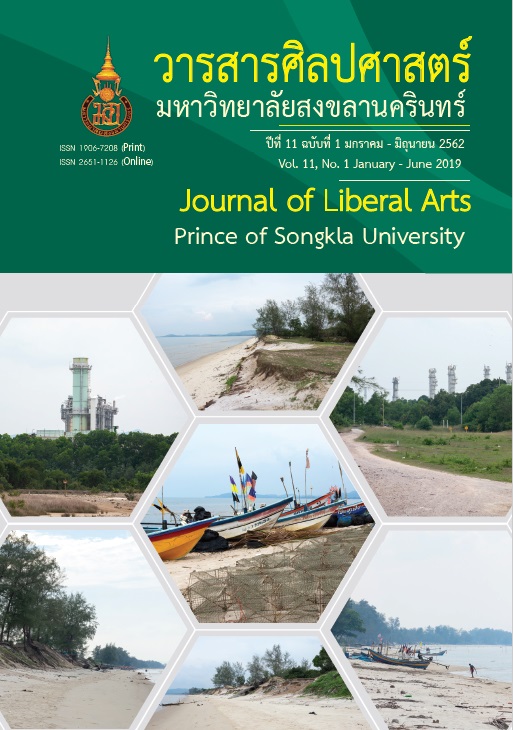ปัจจัยที่ส่งผลต่อการใช้เทคโนโลยีในห้องเรียนของครูที่สอนภาษาอังกฤษในฐานะเป็นภาษาต่างประเทศ
คำสำคัญ:
การใช้เทคโนโลยีของครู, ปัจจัยที่ส่งผลต่อการใช้เทคโนโลยี, อุปกรณ์ช่วยสอนบทคัดย่อ
ในปัจจุบันเทคโนโลยีมีบทบาทสำคัญในการจัดการเรียนการสอนเพื่อใช้ในการสร้างและแลกเปลี่ยนองค์ความรู้ในวงการการศึกษาในหลาย ๆ ประเทศทั่วโลก ในประเทศไทย เทคโนโลยีได้ถูกนำมาใช้เป็นอุปกรณ์ช่วยสอนและอุปกรณ์การจัดการเรียนการสอนภาษาอังกฤษหลายปีที่ผ่านมา ซึ่งครูผู้สอนสามารถนำเทคโนโลยีมาใช้ในห้องเรียนเพื่อเป็นสื่อการเรียนการสอน โดยเฉพาะการสอนภาษาอังกฤษ อย่างไรก็ตาม บริบทห้องเรียนในประเทศไทยยังพบช่องว่างการใช้เทคโนโลยีของครูผู้สอนในการจัดการเรียนการสอนภาษาอังกฤษ ดังนั้น การวิจัยครั้งนี้มีวัตถุประสงค์เพื่อศึกษาประเภทของเทคโนโลยีที่ครูผู้สอนภาษาอังกฤษใช้ในการจัดการเรียนการสอน และศึกษาปัจจัยที่ส่งผลต่อการใช้และไม่ใช้เทคโนโลยีในห้องเรียนของครูผู้สอนภาษาอังกฤษในฐานะภาษาต่างประเทศ เครื่องมือที่ใช้ใน การวิจัย คือ การสัมภาษณ์แบบกึ่งโครงสร้าง (semi-structured interviews) ประชากรในการวิจัย คือ ครูผู้สอนภาษาอังกฤษในฐานะภาษาต่างประเทศ จำนวน 12 คน โรงเรียนวัดนวลนรดิศ กรุงเทพมหานคร
ผลการวิจัยพบว่า 1) ครูทุกคนนำเทคโนโลยีไปใช้ในการจัดการเรียนการสอนในห้องเรียน 2) ครูทุกคนนำเทคโนโลยีหลากหลายประเภทไปใช้ในห้องเรียน แต่มีเพียงแค่เทคโนโลยีที่ทันสมัยบางประเภทเท่านั้นที่ถูกนำไปใช้ 3) ปัจจัยสำคัญที่ส่งผลต่อการใช้เทคโนโลยีของครู คือ ความสะดวก เพิ่มความเข้าใจในเนื้อหาการเรียนของผู้เรียนเร็วขึ้น และกระตุ้นผู้เรียนให้เกิดความสนใจในเนื้อหาการเรียนมากขึ้น แต่อย่างไรก็ตามผลการวิจัยพบว่า ยังมีอีกหลายปัจจัยที่ทำให้ครูไม่ใช้เทคโนโลยีในห้องเรียน อีกทั้งงานวิจัยชิ้นนี้ได้นำเสนอแนวทางในการนำเทคโนโลยีมาใช้ในกระบวนการการจัดการเรียนการสอนภาษาอังกฤษอีกด้วย
References
Abukhattala, I. (2016). The use of technology in language classrooms in Libya. International Journal of Social Science and Humanity, 6(4), 262-267.
Agnes, C., & Wallace, C. (2010). An investigation of factors affecting the use of ICT for teaching in the Western Cape schools. 18th European Conference on Information Systems, Pretoria, South Africa, 7-9 June, pp. 61-72.
Ahadiat, N. (2005). Factors that may influence or hinder use of instructional technology among accounting faculty. Campus-Wide Information Systems, 22(4), 210-232.
Almekhlafi, A. G., & Almeqdadi, F. A. (2010). Teachers’ perceptions of technology Integration in the United Arab Emirates school classrooms. Educational Technology & Society, 13(1), 165–175.
Alsied, S. M., & Pathan, M. M. (2013). The use of computer technology in EFL classroom: Advantages and implications. International Journal of English Language & Translation Studies, 1(1), 61-71.
Amina, M., & Salim, M. (2015). The use of educational technology in EFL teaching and learning : Case study of second year sstudents at Tlemcen University. Master in Language Studies, English Language Studies, Faculty of Letters and Languages, Tlemcen Univresity.
Asawaniwed, P., & Boonmoh, A. (2012). Attitudes of Thai EFL learners toward the use of blogs. The Fourth TCU International E-Learning Conference, Muang Thong Thani, Nonthaburi, Thailand, 14-15 June, pp. 313-319.
Bani Hani, N. A. (2014). Benefits and barriers of computer assisted language learning and teaching in the Arab world: Jordan as a model. Theory and Practice in Language Studies, 4 (8), 1609-1615.
ChanLin, L.-J., Hong, J.-C., Horng, J.-S., Chang, S.-H., & Chu, H.-C. (2006). Factors influencing technology integration in teaching: a Taiwanese perspective. Innovations in Education and Teaching International, 43(1), 57-68.
Durđanović, M. M. (2015). The use of teaching aids and their importance for students’ music education. (IJCRSEE) International Journal of Cognitive Research in Science, Engineering and Education, 3(2), 33-40.
Eady, M. J., & Lockyer, L. (2013). Tools for learning: Technology and teaching strategies. University of Wollongong Research Online, 14(1), 71-89.
Günüç, S., & Kuzu, A. (2014). Factors influencing student engagement and the role of technology in student engagement in higher education: Campus-class-technology theory. Turkish Online Journal of Qualitative Inquiry, 5(4), 86-113.
Herschbach , D. R. (1995). Technology as knowledge: Implications for instruction. Journal of Technology Education, 7(1), 31-42.
Hjalmarsson, H. (2015). The effects of ICT on affective factors and teaching practices in the EFL and ESL classroom. Master’s thesis in Teacher Education, Languages and Literatures, Faculty of Education, Gothenburg University.
Konomi, D. K. (2015). Using visual materials in teaching vocabulary in English as a foreign language classrooms with young learners. International Conference New Perspectives in Science Education, Firenze, Italy, 20-21 March, pp. 23-35.
Lin, M.-H., Chen, H.-C., & Liu, K.-S. (2017). A study of the effects of digital learning on learning motivation and learning outcome. EURASIA Journal of Mathematics Science and Technology Education, 13(7), 3553-3564.
Merç, A. (2015). Using technology in the classroom: A study with Turkish pre-service EFL teachers. TOJET: The Turkish Online Journal of Educational Technology, 14(2), 229-240.
Prensky, M. (2001). Digital natives, digital immigrants. MCB University Press, 9(5), 2-6
Senaidi, S., Lin, L., & Poirot, J. (2009). Barriers to adopting technology for teaching and learning in Oman. Computers & Education, 53(3), 575-590.
Shabiralyani, G., Hasan, K. S., Hamad, N., & Iqbal, N. (2015). Impact of visual aids in enhancing the learning process case research: District Dera Ghazi Khan. Journal of Education and Practice, 6 (19), 226-233.
Shivalingaiah , D., & Naik, U. (2009). Comparative study of Web 1.0, Web 2.0 and Web 3.0. Conference: 6th International CALIBER 2008, Allahabad, Uttar Pradesh, India, 28-28 February, pp. 499-507.
Shyamlee, S. D., & Phil, M. (2012). Use of technology in English language teaching and learning: An analysis. 2012 International Conference on Language, Medias and Culture ICLMC, Chennai, India, 10-11 March, pp. 151-156.
Solomon, G., & Schrum, L. (2007). Web 2.0: New tools, new schools . International Society for Technology in Education, the United States of America.
Yordming, R. (2017). Teachers’ perspective towards digital teaching tools in Thai EFL classrooms. International Journal of Languages, Literature and Linguistics, 3(2), 45-48.
Downloads
เผยแพร่แล้ว
How to Cite
ฉบับ
บท
License
ลิขสิทธิ์บทความเป็นของผู้เขียน แต่วารสารศิลปศาสตร์ มหาวิทยาลัยสงขลานครินทร์ ขอสงวนสิทธิ์ในการเป็นผู้ตีพิมพ์เผยแพร่เป็นครั้งแรก




